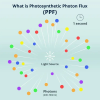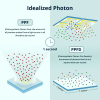
Photosynthetic photon flux (PPF) refers to the total amount of light in the PAR range that a light source produces per second.
By knowing the PPF value of a grow light, you can estimate or calculate the number of lights needed per area to achieve the desired light level for your plants. Let's consider the example of a strawberry grower doing winter cultivation, aiming for a light level of 200 μmol/sm². Let's say each growing area has a total area of 40m². In this case, you would need 40m² x 200 μmol/sm² = 8000 μmol of light for that particular area. Now, let's assume a single LED grow light emits a PPF of 2000 μmol/s. To achieve the required light level, you would need 8000 μmol / 2000 μmol/s = 4 lights for each growing area.
Note that PPF represents the total number of PAR photons emitted by a light source in all directions, not the number of photons effectively reaching your plants. To determine the number of photons reaching your plants, you must consider the photosynthetic photon flux density (PPFD) measurement.
How do we measure PPF??
Measuring PPF involves performing a sphere test. This test involves placing the light fixture in a round sphere, quantifying the emission of PAR photons in all directions. The sphere test continuously records the number of PAR photons the device emits per second, and the results are typically presented in micromoles per second (μmol/s)
.

PPFD, which stands for photosynthetic photon flux density, refers to the amount of PAR photons that reach a certain surface within a certain time. It provides useful information about the amount of PAR light plants receive at different measurement points. PPFD measurements are expressed in micromoles per square meter per second (μmol/m²/s).
Different plant species have specific PPFD requirements for optimal growth and yield. For example, flowering plants like cannabis typically require about 300-600 μmol/s during the vegetative phase and 800-1000 μmol/s during flowering. These measurements represent the PPFD values needed.
However, it is important to note that PPFD has its limitations. One disadvantage is that it treats all photons in the 400–700 nm range equally, even though red and blue light play a more important role in photosynthesis.
Furthermore, PPFD focuses solely on PAR in this range, without considering the potential effects of UV and infrared light, which have been found to stimulate the production of secondary metabolites in plants.
Additionally, PPFD can easily be exaggerated. Manufacturers may specify unrealistic distances between the plant canopy and the light source, resulting in higher PPFD values. However, these distances are impractical due to factors such as the heat generated by the lighting system.
Despite these limitations, PPFD remains the best metric available for assessing the effectiveness of LED grow lights. When comparing different lighting systems, it is important to closely examine PPFD values to make informed decisions.
How do we measure PPFD?
PPFD is commonly assessed using a PAR meter, which can be positioned at different locations or heights to measure the actual light intensity at those specific spots. However, it is important to note that a PAR meter primarily measures the direct light emitted by the source and may not accurately measure light coming from the sides. In many cases, a combination of direct and indirect light hitting the plants from different angles is beneficial. This allows for deeper light penetration into the plant canopy and promotes better yield overall.
In a small-scale grow facility, using a tent where the light reflects off the sides and directly illuminates the plants tends to be more beneficial. This allows for more extensive light distribution within the limited space. On the other hand, in larger deployments with multiple lights, it is often more effective to hang the lights at higher positions. This arrangement ensures that each plant receives light from multiple angles, optimizing light coverage. Unfortunately, a standard PAR meter may not accurately measure this multi-directional lighting configuration.
Efficacy (umol/j) vs. PPF (w) Explained: LED Grow Lights Demystified: Efficacy (umol/j) vs. PPF (w) Explained - LED Grow Lights (420ledguide.com)
idk my caluma force lamp is 150 watt and had efficiency:
2,7 µmol/J ppf: 375 µmol/s and is for 80x80cm growbox at best better 60x60cm! cost 249 euro. iam new to growing but i know spider farmer, vipaspectra, mars hydro is all crap...
best lights are these lumatek, caluma, sanlight, greenception look here (sanlight and greenception is high budget) =
Grow LED: breite Auswahl und günstige Preise (grow-guru.com).
and the best low budget lights like these
ATS 200W Pro (grow-guru.com) are having efficiency:
2,5 µmol/J ppf:
508 µmol/s. and this is the 200watt for 369 euro (and she cost 100 to 150 euros more then mars,spider,viparspectra, becoose she is better belive me ! and here lumatek, caluma is low budget you became the most for your money 100%.
the biggest lumatek 1000 watt for 1549 euro
Lumatek Zeus 1000W PRO LED 2.9 (grow-guru.com) has efficiency:
2,9 µmol/J ppf:
2925 µmol/s. idk what we talking about, and maybe i not understand it....idk why you in america or in rest of world buy other then the low or high budget mercedes under the leds for just a little amount more and know you do all right, and the lamp will not to belie you...here in city growshop they dont sell spider,mars,vipaspectra becoose noone will buy it....
and the best is the vipaspectra 600 was one year ago 50 euro at amazon, last month they try at amazon for 169 euro...then go back to 89 euro, now 99 euro becoose noone buy it
VIPARSPECTRA P600 LED Grow Lampe 100w, Pflanzenlampe LED Vollspektrum, Pflanzenlampen LED Grow Light, 4 Levels Dimmen 0%-100% für Zimmerpflanzen Sämling Gemüse Blüte für Growzelt 60x60cm 40x40cm : Amazon.de: GartenLOL
as example better buy for 50-60 euro more the 75 watt caluma then the vipspectra p600
Caluma LED Force 75W (grow-guru.com)...
Delps8 say the vipaspectra xs150 pro is top?????? i say she is trash! 249 euro regular now 199 euro becoose noone buy it like i say, and i quarantee is not better then my caluma 150 watt for 249euro maybe 25%-35% worse
VIPARSPECTRA XS1500 Pro LED Grow Lampe,Pflanzenlampe LED Vollspektrum,Neue Gen Linsen LED Grow Light mit Daisy-Chain 4 Levels Dimmen 0-100% Für Zimmerpflanzen Gemüse Blüte für Growzelt 90x90cm 60x60cm: Amazon.de: Garten
and the youtubers just say what the sponsor will hear for sponsoring and after video they maybe use other lights ha ha ha....
my light = caluma led force 150 watt:


Caluma LED Force 150W
The Caluma LED Force 150W is an inexpensive grow lamp that impresses with its decent light output and functional features. This gives you full control over your grow, but doesn't put a hole in your wallet.
The Caluma Force 150 W has an integrated dimmer in its driver so that you can precisely regulate the lighting situation. This allows you to adjust the light intensity to the needs of your favorite plants from the young plant to the finished fruit and grow healthier plants.
With the Caluma Force 150W you get a PPF of 375 µmol/s from 150 watts of power, which means you can perfectly illuminate a growing area of up to 80 x 80 cm.
With its long lifespan of at least 50,000 operating hours and an efficiency of 2.5 µmol/J, the Caluma Force 150W is a long-lasting LED grow lamp that you can always use to illuminate your plants appropriately.
Intended use
All plant stages from cultivation to flowering
For smaller grow boxes up to 80 x 80 cm
Advantages of the Caluma LED Force 150W
Affordable price
Long lifespan with 50,000+ operating hours
Little waste heat & passive cooling (noiseless)
Plug & Play
Built-in dimmer
2x suspension included
Recommended additional products
Timer
So that you can set the length of the lighting phases for your plants, you should control each grow lamp with a timer. If a slight humming noise doesn't bother you, then you can boldly use an analog timer. There are now also digital models that can be set even more precisely, so that you can set your switching time to a specific time.
Multiple socket
If you want to operate several lamps, we recommend purchasing a multiple socket. This way you avoid unnecessary cable clutter and always keep an overview.
Technical details
Power:
150 watts
Distance from plant:
25 - 35 cm
Type:
Full spectrum LED panel
Dimensions:
38 x 38 x 7 cm
Service life:
50,000 operating hours
Cooling:
Passive cooling
PPF:
375 µmol/s
Efficiency:
2.7 µmol/J
LED assembly:
Seoul SMD2835
Seoul SMD3535
Beam angle:
120°
Protection class:
IP65 standard
Weight:
2.8 kg
Scope of delivery
Caluma LED Force 150W
IEC cable
LED driver
Hanging system
Operating instructions




